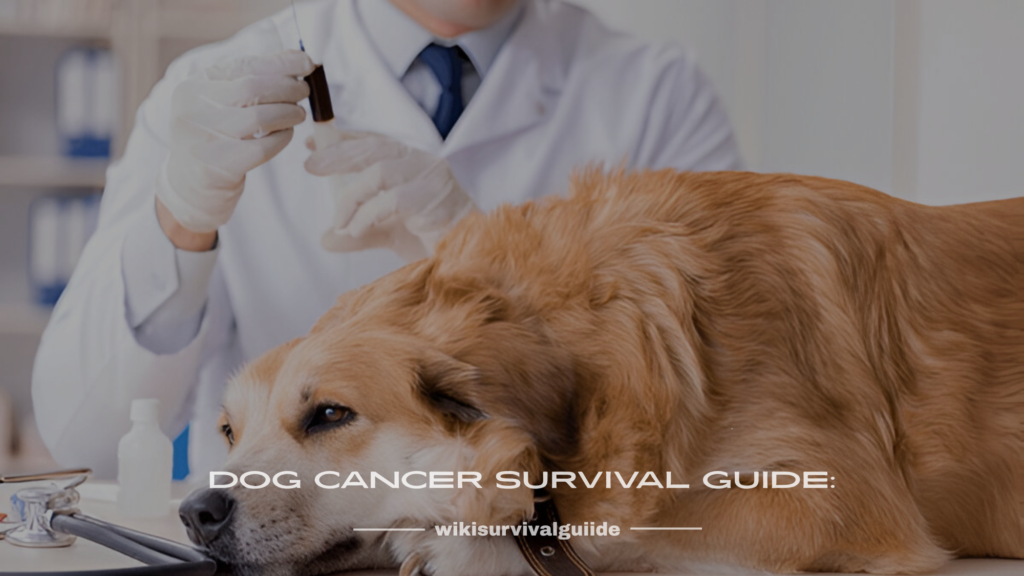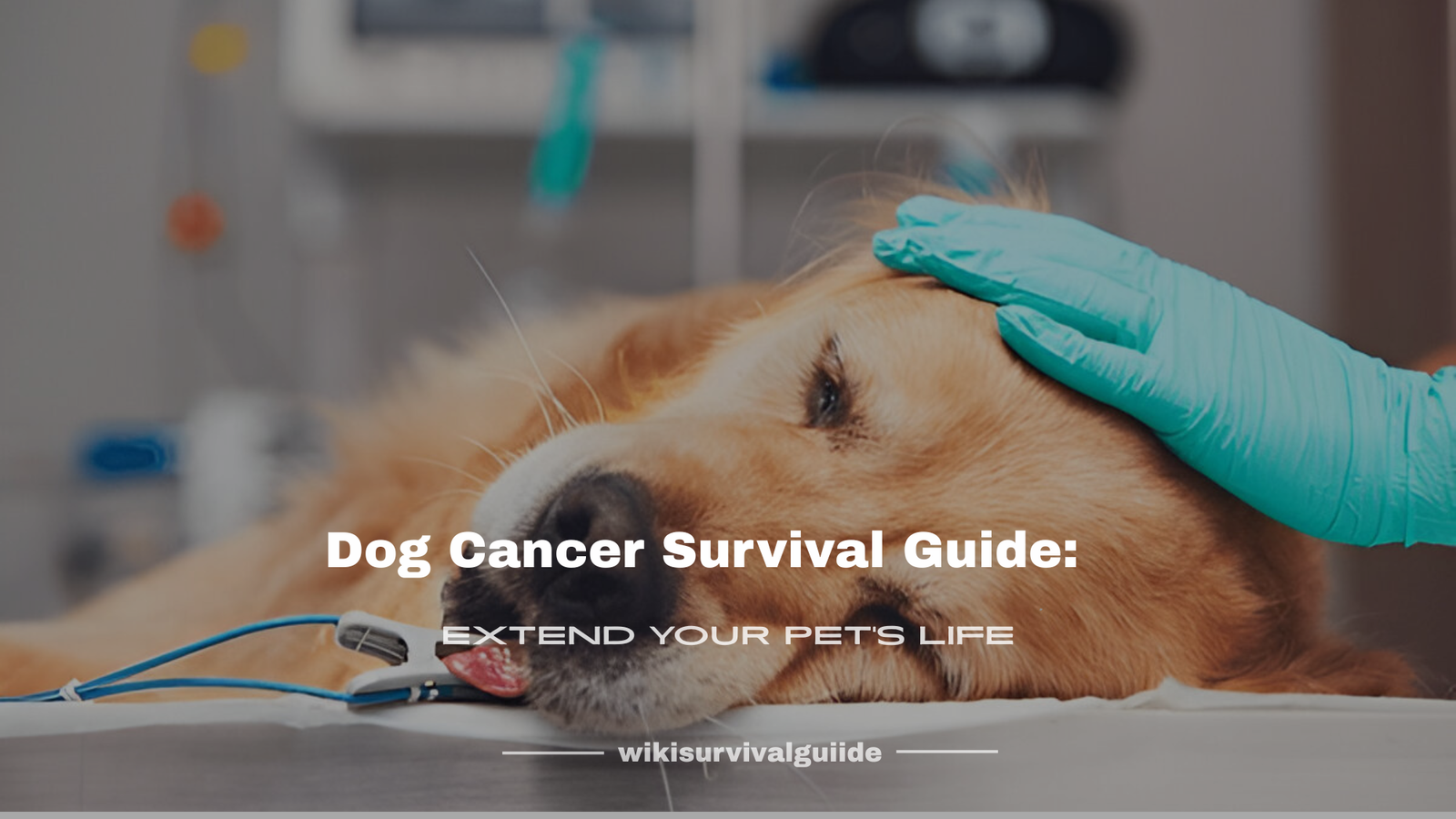When a beloved dog is diagnosed with cancer, it can feel like the world shifts beneath your feet. The Dog Cancer Survival Guide is more than just a book—it’s a lifeline. This guide provides clear, actionable advice to help pet parents navigate treatment options, manage side effects, and ensure their dog’s comfort. From nutrition to emotional support, it arms you with knowledge and peace of mind to make informed, compassionate choices.
Understanding Dog Cancer: Types, Causes, and Symptoms
Dog cancer is a general term for a range of diseases that result from the abnormal growth of cells in your dog’s body. These growths can be benign (non-cancerous) or malignant (cancerous). Some of the most common types of cancer in dogs include lymphoma, mast cell tumors, osteosarcoma (bone cancer), mammary tumors, and hemangiosarcoma (blood vessel cancer). The exact cause of cancer in dogs remains largely unknown, though certain breeds may be genetically predisposed to specific cancers. Environmental factors like exposure to toxins, chemicals, or second-hand smoke, as well as age, can increase the risk. Older dogs are more likely to develop cancer due to a decrease in the body’s ability to repair damaged cells over time.
The symptoms of cancer vary depending on the type and location. Lumps or masses that can be felt under the skin are often an early sign. Other common symptoms include unexplained weight loss, loss of appetite, vomiting, lethargy, excessive coughing, and difficulty breathing. Skin lesions, sores that won’t heal, or bleeding in unusual places are also warning signs. Early detection of cancer in dogs is crucial because it increases the likelihood of successful treatment. If you notice any abnormal changes in your dog’s behavior, health, or physical appearance, it’s important to contact your vet as soon as possible for an examination.
Early Warning Signs: How to Detect Cancer in Your Dog
Cancer can be tricky to detect in its early stages, as symptoms often mimic less severe health issues. However, there are key early warning signs to look out for that may indicate your dog is battling cancer. One of the most common early signs is the appearance of lumps or bumps under your dog’s skin, which may be soft or hard to the touch. If you notice any unexplained growths, don’t wait—have them examined by your veterinarian. Another critical sign is sudden weight loss or lack of appetite. If your dog suddenly stops eating or seems to be losing weight without explanation, it could be a symptom of cancer or other serious illnesses.
Excessive lethargy or a decrease in activity level is another potential red flag. Dogs that normally have lots of energy may become unusually tired or sluggish. Changes in your dog’s bathroom habits, such as difficulty urinating, blood in the urine, or diarrhea, may also signal a problem. Persistent coughing, especially when paired with labored breathing, is a common sign of respiratory cancers. Other subtle signs include bad breath, excessive drooling, and bleeding from the nose or mouth.
If your dog shows any of these signs or any other abnormal behaviors, it’s important to act quickly. Early detection often leads to better treatment options and outcomes. A visit to your vet is essential, as they can run the appropriate tests to identify or rule out cancer.
Diagnostic Tests and Procedures for Canine Cancer
When your dog shows signs of potential cancer, your veterinarian will conduct a thorough examination and may recommend a series of diagnostic tests to confirm the presence of cancer and determine its type. The process typically begins with a physical exam, where the vet will look for external signs such as lumps, skin lesions, or swelling. A detailed history of your dog’s symptoms, lifestyle, and environment will also be reviewed to assist in diagnosis.
Blood tests are often the first step in diagnostic testing. They can reveal underlying health issues that might point to cancer, such as abnormal cell counts, liver, or kidney function. If cancer is suspected, your vet may proceed with imaging tests like X-rays, ultrasound, or CT scans to examine internal organs for tumors or abnormal masses. These imaging procedures can help identify the size, location, and spread of the cancer.
Biopsy is a definitive test for cancer diagnosis. It involves removing a small tissue sample from the suspicious mass, which is then examined under a microscope to determine if cancer cells are present. In some cases, a fine needle aspirate (FNA) may be used to extract fluid or cells from the tumor, which can also be analyzed. Once the diagnosis is confirmed, your vet may conduct additional tests, like lymph node sampling, to see if the cancer has spread (metastasized). These tests are vital to develop an appropriate treatment plan tailored to your dog’s condition.

Creating a Treatment Plan That Works for Your Dog
Once a cancer diagnosis is confirmed, it’s essential to create a comprehensive treatment plan that aligns with your dog’s specific condition, cancer type, and overall health. The first step in developing a treatment plan is to discuss the various treatment options with your veterinarian. These may include surgery, chemotherapy, radiation therapy, or alternative and supportive therapies.
Surgical intervention is often the first option when a tumor is localized and can be safely removed. This treatment offers the best chance for a cure or remission, particularly if the cancer has not spread. However, surgery is not always feasible, especially for cancers that are widespread or inoperable due to the tumor’s location.
Chemotherapy and radiation therapy are commonly used when surgery is not an option or as adjuvant therapies following surgery. Chemotherapy involves using powerful drugs to kill cancer cells or prevent their growth. It may be used as the primary treatment for cancers like lymphoma or in combination with surgery for other types of cancer. Radiation therapy is often used to target localized tumors and reduce their size, offering a chance to alleviate pain or improve function in areas like the brain or chest.
Additionally, holistic approaches, such as dietary changes, herbal supplements, and acupuncture, can help support your dog’s health during cancer treatment and improve their overall quality of life. A well-rounded approach to treatment is crucial, and you should work closely with your veterinarian and possibly an oncologist to develop a plan that best fits your dog’s needs.
Chemotherapy for Dogs: What to Expect
Chemotherapy is a common cancer treatment that involves the use of drugs to destroy or inhibit the growth of cancer cells. While chemotherapy in dogs is similar to that in humans, the protocols and drugs used may differ depending on the type of cancer your dog has. One of the biggest concerns among pet owners is how their dog will handle chemotherapy. Fortunately, dogs generally tolerate chemotherapy better than people, although side effects can still occur.
Some dogs may experience mild side effects, such as nausea, vomiting, or lethargy, while others may develop more serious symptoms like low blood cell counts, which can increase the risk of infection. Fortunately, these side effects are often temporary, and your veterinarian will closely monitor your dog’s condition to adjust treatments if needed.
Chemotherapy is usually administered in cycles, with a period of treatment followed by a recovery phase. The treatment itself is typically given intravenously at your vet’s office, but some oral chemotherapy medications may also be prescribed for home use. Many dogs can continue their regular activities, including eating, playing, and walking, throughout treatment.
Chemotherapy can be used as the primary treatment for cancers like lymphoma or as part of a combination therapy. In some cases, chemotherapy can offer remission, or at least help slow the progression of cancer, providing your dog with more time and a better quality of life. The decision to proceed with chemotherapy should be based on the type of cancer, its stage, and your dog’s overall health. Always discuss potential benefits and risks with your veterinarian.
Radiation Therapy in Dogs: Safety and Success Rates
Radiation therapy is an effective cancer treatment that uses high-energy radiation to target and destroy cancer cells. This treatment is commonly used in cases where surgery is not possible or as an adjunct to surgery to target any remaining cancer cells. Radiation therapy is typically used to treat localized tumors, such as those in the brain, nose, or chest, and can be particularly effective for cancers that are difficult to reach surgically.
During radiation therapy, your dog will be placed under general anesthesia, as the procedure requires your pet to remain completely still. The radiation is directed at the tumor site using a machine called a linear accelerator. While the process may sound daunting, the procedure itself is painless, and your dog will not feel the radiation.
Radiation therapy usually involves multiple treatment sessions, often spanning several weeks. Although radiation therapy is highly effective in reducing or shrinking tumors, it can cause some side effects, including temporary hair loss at the treatment site, mild skin irritation, or gastrointestinal upset. These side effects are generally short-lived, and your veterinarian will monitor your dog’s progress closely throughout treatment.
The success rates of radiation therapy depend on the cancer type, tumor location, and how early the cancer is diagnosed. In some cases, radiation therapy can offer significant pain relief and improve quality of life. In others, it can help extend survival by preventing the cancer from growing or spreading. Radiation therapy is typically a safe and well-tolerated option for many dogs, and it can be a powerful part of your dog’s cancer treatment plan. Always consult with your vet to determine if radiation therapy is a suitable option for your dog’s specific case.
Surgical Options and Post-Op Care
Surgery is often the first line of defense against many types of canine cancer, particularly when the tumor is localized and hasn’t yet spread to other parts of the body. Surgical options depend on the type, size, and location of the tumor. Some surgeries are relatively minor, involving skin tumors or accessible growths, while others may require removal of organs or limbs, such as with osteosarcoma.
The primary goal of surgery is to remove the entire tumor with clean margins, which reduces the risk of recurrence. In some cases, surgery may be combined with chemotherapy or radiation for a more comprehensive treatment approach. The success of surgery can be high, especially if the cancer is caught early.
Post-operative care is just as crucial as the surgery itself. Dogs recovering from cancer surgery may need rest, limited movement, pain medication, and wound care. It’s important to monitor your dog closely for signs of infection, such as swelling, redness, or discharge at the incision site. Your vet will provide instructions on feeding, medication, and activity restrictions during the healing process.
Follow-up visits are essential to track recovery and monitor for signs of recurrence. Depending on your dog’s condition, additional treatments may be recommended. Emotional care matters too—dogs recovering from surgery may feel confused or anxious, so maintaining a calm and comforting environment is key. With proper surgical planning and attentive post-op care, many dogs go on to enjoy a significantly improved quality of life.
Holistic and Natural Approaches to Dog Cancer
Holistic and natural approaches to dog cancer focus on supporting your dog’s overall health and well-being rather than targeting the disease alone. These methods are often used in combination with traditional treatments like chemotherapy or surgery to enhance recovery, minimize side effects, and improve your dog’s quality of life.
Holistic care involves the whole body—physically, emotionally, and mentally. Techniques can include acupuncture, chiropractic care, massage therapy, and homeopathy. Acupuncture, in particular, has gained popularity in veterinary oncology for its ability to reduce pain, improve energy levels, and support immune function. Herbal medicine is another avenue, where specific herbs like turmeric (curcumin), astragalus, or milk thistle may be used for their anti-inflammatory, immune-boosting, or detoxifying effects.
A natural diet plays a significant role in holistic care. Feeding your dog nutrient-dense, whole foods like lean proteins, leafy greens, and antioxidant-rich fruits can support cellular health and recovery. Many pet owners also turn to raw or homemade diets designed by veterinary nutritionists.
It’s important to remember that while holistic treatments can be beneficial, they should always be guided by a veterinarian—preferably one with experience in integrative medicine. Not all natural remedies are safe for all dogs, especially those undergoing conventional cancer treatment. The key is finding a balance between traditional and holistic methods that work best for your dog’s condition and lifestyle. When done correctly, holistic care can help dogs feel better, heal more quickly, and live longer, more comfortable lives.
Nutrition and Diet Plans for Dogs with Cancer
Proper nutrition is one of the most powerful tools in supporting a dog with cancer. Cancer can place a significant metabolic burden on the body, making it crucial to fuel your pet with the right nutrients to fight the disease, support immunity, and maintain strength. Many veterinarians recommend a high-protein, low-carbohydrate diet for dogs with cancer. This is because cancer cells tend to feed on simple carbs and sugars, while healthy cells benefit more from protein and fat-based energy sources.
Your dog’s diet should include lean meats such as chicken, turkey, or fish, along with healthy fats like omega-3 fatty acids found in fish oil. These fats are known to reduce inflammation and may slow the growth of some tumors. Include non-starchy vegetables like broccoli, spinach, and zucchini, which are rich in antioxidants and help fight oxidative stress.
It’s also essential to avoid processed foods and commercial kibble high in grains, fillers, or artificial additives. Many pet parents opt for home-cooked meals or raw food diets, but these should always be prepared under the guidance of a veterinary nutritionist to ensure balance and safety.
Dogs undergoing cancer treatment may lose their appetite or experience nausea. In such cases, you can offer smaller, more frequent meals or incorporate bone broth, boiled meats, and digestive enzymes to encourage eating. Supplements like probiotics and B-vitamins can also help with digestion and energy levels.
Ultimately, a tailored diet can significantly impact your dog’s comfort and longevity. Work closely with your vet to create a plan that meets your dog’s specific nutritional needs.
Supplements That Support Canine Cancer Recovery
Supplements can play a supportive role in helping dogs recover from cancer by boosting their immune system, improving digestion, reducing inflammation, and enhancing overall health. While not a cure, when combined with traditional treatments like chemotherapy or surgery, supplements can provide essential nutrients that the body needs to heal and fight disease more effectively.
Omega-3 fatty acids, especially those from fish oil, are among the most commonly recommended supplements. They have anti-inflammatory properties and have been shown to help slow the growth of certain cancer cells. Antioxidants such as vitamins C and E, selenium, and coenzyme Q10 help protect cells from damage and may reduce the side effects of cancer treatments.
Probiotics are beneficial for maintaining gut health, which is often compromised during cancer treatment. A healthy gut is key to proper nutrient absorption and immune function. Digestive enzymes can also support your dog’s ability to break down and absorb food more efficiently, especially when appetite or digestion is poor.
Other popular supplements include medicinal mushrooms (like reishi, maitake, and shiitake), which are believed to support the immune system and may have anti-tumor properties. Turmeric (curcumin), green tea extract, and CBD oil are also gaining attention for their potential anti-cancer benefits.
It’s crucial to consult your veterinarian before starting any supplement, as some may interfere with medications or treatments. Proper dosing is essential, and every dog’s needs are different. When used correctly, supplements can be a powerful addition to your dog’s cancer care regimen, helping them feel better and heal more efficiently.
Managing Side Effects of Cancer Treatment
Cancer treatment can be tough on dogs, just like it is on humans. Managing side effects is an essential part of care, not just for your dog’s comfort but also to help them stick with the treatment long enough to see results. Common side effects of chemotherapy and radiation include fatigue, nausea, vomiting, loss of appetite, and changes in behavior or bowel movements.
Fatigue is often the most noticeable. Your dog might sleep more or be less interested in play. Make sure they have a quiet, comfortable place to rest, and avoid forcing activity. Nausea and vomiting can be managed with anti-nausea medications prescribed by your vet. You can also offer bland, easy-to-digest meals like boiled chicken and rice or bone broth to soothe the stomach.
Loss of appetite is another issue. Try warming your dog’s food slightly to make it more aromatic, or offer high-value treats like bits of cooked meat. Appetite stimulants can also be used in more severe cases. Diarrhea or constipation may occur, especially if your dog is on medications. Ensure they have access to fresh water and consider adding pumpkin or probiotics to their meals to support digestion.
Mental and emotional changes are also common—your dog may become clingier or more withdrawn. Be patient and offer plenty of comfort.
Regular vet check-ins are important to monitor your dog’s health and adjust medications or treatments if necessary. Managing side effects well can make a huge difference in your dog’s well-being and help them respond better to treatment.
Pain Management and Comfort Care
Pain management is a vital part of caring for a dog with cancer. Whether it’s due to the tumor itself, surgery, or side effects from treatment, pain can significantly affect your dog’s quality of life. Recognizing pain in dogs can be tricky, as they often hide it well. Look for signs like limping, whining, excessive licking, withdrawal, or reluctance to move or eat.
Veterinarians use a variety of tools to control pain in dogs with cancer. Non-steroidal anti-inflammatory drugs (NSAIDs) are commonly prescribed for mild to moderate pain. For more severe pain, opioids such as tramadol or morphine may be used. Gabapentin is another drug often prescribed for nerve pain.
Complementary therapies like acupuncture, cold laser therapy, and massage can help relieve pain without relying solely on medication. These methods are often used in holistic care plans and can be especially effective when combined with traditional pain meds.
Environmental comfort matters too. Make sure your dog’s bed is soft and easy to access. Avoid stairs if they’re struggling with mobility, and keep food and water within easy reach. Heated beds or pads can also help soothe aching joints or muscles.
Comfort care also includes emotional support. Dogs sense our energy, so staying calm and positive can help reduce their stress. Spend quality time together, offer gentle petting, and maintain a routine to help your dog feel safe and secure.
Pain management is not just about physical relief—it’s about preserving dignity, comfort, and joy during your dog’s journey with cancer. Always work closely with your vet to tailor a plan that meets your dog’s unique needs.
Conclusion
Facing canine cancer is tough, but you don’t have to do it alone. The Dog Cancer Survival Guide empowers you with expert strategies, heartfelt support, and hope. With the right tools and mindset, you can provide your furry friend with the best care possible, no matter where this journey takes you.
FAQs
1. How can I emotionally support my dog during cancer treatment?
Spend quality time, maintain routines, offer comfort, and create a calm environment to reduce stress.
2. What should I ask my vet about canine cancer?
Ask about diagnosis, treatment options, side effects, prognosis, and at-home care needs.
3. Are there financial aid options for dog cancer treatment?
Yes, options include pet insurance, non-profit grants, payment plans, and crowdfunding platforms.
4. How is cancer care different for senior dogs?
Senior dogs may need gentler treatments and extra comfort measures due to age-related health issues.
5. Can dogs survive cancer and live a normal life?
Yes, many dogs recover and enjoy a good quality of life, especially with early detection and proper care.




Leave a Comment